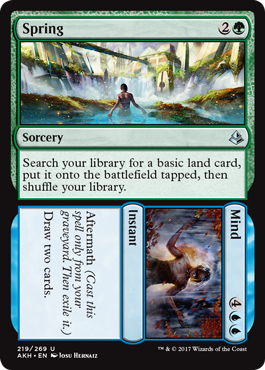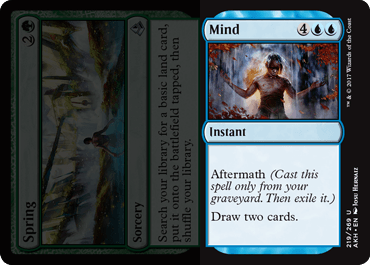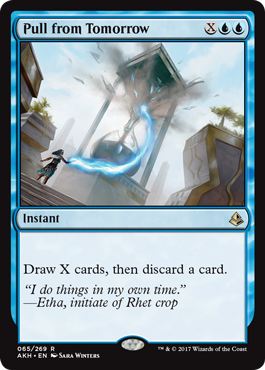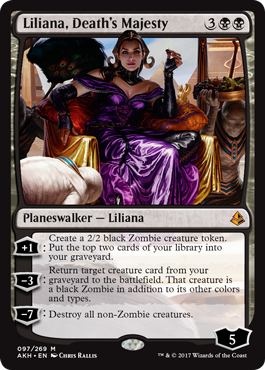Doing the Aftermath
Every Magic set is full of new cards and abilities to discover—and Amonkhet brings a bounty of exciting new riches to try.
On top of all the embalming, exerting, and wonderfully Egyptian cards is something fresh and wild. It's an entirely new-looking kind of card coming to you in Amonkhet, that appears quite different than anything you've seen before.
Let's cut right to the chase. I'm talking about "aftermath," Amonkhet's radical take on two-cards-in-one.
What better way to kick off this discussion than with a new aftermath card you can expect to make the full circuit of tables—from the kitchen table to the tournament table! (Just don't expect it to table in a draft.)
Feast your eyes on Spring to Mind!

This card is sleek. This card is fun to play with, enabling some of my favorite deck archetypes. And, perhaps most of all, this card is powerful.
Now, it may not necessarily look that way at first glance. After all, aren't those two wildly over-costed effects? Why wouldn't you just play with Inspiration or something instead?
That's a reaction you may have time and time again when reading aftermath cards. And yet, I can tell you from experience playing with the mechanic, these are incredibly powerful. Trust me, you won't want to underestimate aftermath cards.
Why is that? Let's dive into what makes aftermath tick.
The Secret Card
Aftermath comes from a storied lineage of Magic mechanics that, though they don't say so explicitly, secretly draw you a card.

Take flashback, one of the greatest Magic mechanics of all time. Flashback operates from your graveyard to be cast a second time. But what it really says in a lot of cases is, "The first time you cast this spell, draw another, more expensive copy of this card."
They are all sneakily drawing you a card. It's virtual card advantage.
We all probably have an idea that drawing cards is good. Some of the most powerful cards in the history of the game have been draw spells. So cards that do something and then draw you a card are always worth at least considering.
If the game goes long, Magic turns into a battle about attrition and resources. Drawing a few bonus cards over the course of the game goes a long way toward making sure you win those attrition and resource wars.
The thing aftermath looks most like is probably a split card.
But there's a very big difference here. Split cards are all about choice: You get one or the other, not both. It's a mechanic built on flexibility.
And what the split card is charging you for, most of all, is that flexibility. You're not getting an extra card out of the deal. (Well, unless you're playing the excellent Fire // Ice, of course.)
Aftermath, on the other hand, always gives you that wonderfully useful extra card.
Let's look at aftermath again.

The big difference between aftermath and flashback is that with aftermath, you get a different card—or to extend the above analogy, "draw" a different card—than what you cast the first time. Is that good?
Well, it certainly is when the effects are built to play into each other—which most aftermath cards absolutely are!
Look at Spring to Mind. You get a ramp spell early, which helps you get more mana, which helps you cast the more expensive half of the card from your graveyard. Spring to Mind is self-synergizing!
You would play a three-mana ramp spell that also drew you a card, right? (The high playability of cards like Cultivate point strongly at yes.) Spring to Mind is kind of like that.
And in this particular instance, to sweeten the pot ever more, Spring to Mind is even better than just drawing a second spell to use later—it's drawing you two cards from your deck later on!
What do ramp decks always need? Late-game card draw when they run out of gas.
Well, Spring to Mind fills that need in a way that a flashback ramp spell wouldn't even come close to. Aftermath is something entirely its own.
And, of course, there's one other fundamental advantage aftermath has over simply drawing a card . . .
Drawing Cards Into your Graveyard
Now, there is one big difference from aftermath just being the analog of drawing a card above: you don't even need to have cast the card the first time!
If an aftermath card ends up in your graveyard somehow—say by putting it into your graveyard from your library (milling) or discarding it—you still get value.
And guess what: Amonkhet has plenty of ways to do just that!


Normally, you'd need some other way to make those cards do something—but aftermath does it all on its own.
In the case of Spring to Mind, ramping your mana is something you want early but don't necessarily need later on. So if you get your engine rolling and self-mill some cards into your graveyard, you're just up card advantage in any kind of long game.
If you head over to the Card Image Gallery and peruse some of the other aftermath offerings, there are a lot of devastating effects that a little bit of self-mill can set up for you. Check it all out!
After the Aftermath
Amonkhet is full of new ways to crush your opponents—and a string of aftermath cards out of your graveyard is no exception.
You can expect Spring to Mind, and many of its aftermath brethren, to be powerhouses in the months to come. Pick them highly in Draft, and give them a try in Constructed.
After all, in the world of Amonkhet, you're going to need all the help you can get to survive all Five Trials.
If you have any comments or questions at all, please send them my way! It's always great to hear from you. I can be reached on Twitter, Tumblr, or by sending an email (in English, please) to BeyondBasicsMagic@gmail.com.
I hope you enjoyed this advance look at Spring to Mind and Amonkhet! Be sure to look ahead to try and find a Prerelease near you to go check out the set in person.
I'll talk with you again next week. Enjoy checking out Amonkhet!

